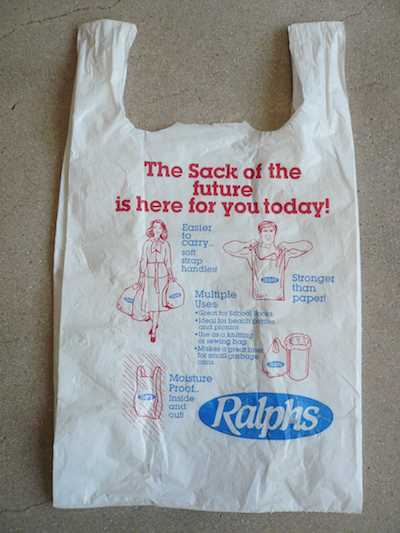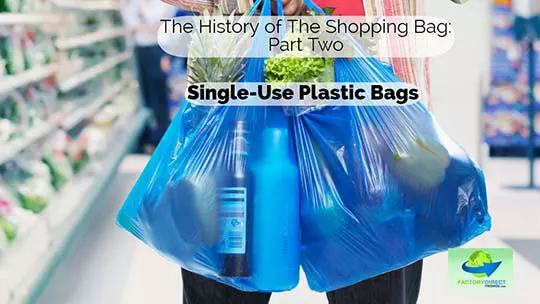
Plastic bags have become a ubiquitous part of our daily lives, but have you ever wondered which country was the first to introduce them?
The answer might surprise you. The credit for introducing plastic bags as a common consumer product goes to Sweden. In the early 1960s, a Swedish packaging company called Celloplast developed a method to manufacture lightweight and durable bags from polyethylene, a type of plastic. These bags quickly gained popularity due to their convenience and affordability.
However, the initial purpose for inventing plastic bags was not as a shopping bag, but rather as a means to store food. Celloplast saw an opportunity to revolutionize the way food was packaged and preserved. The bags were initially sold to grocery stores and markets as a new and innovative way to store perishable items. It wasn’t until later that plastic bags were adopted by consumers as a convenient way to carry their purchases home.
Despite their initial success, plastic bags have since become a major environmental concern. The durable nature of plastic means that it can take hundreds of years to break down in the environment. This has led to widespread pollution, particularly in our oceans, where marine life is often harmed by the presence of plastic waste. As a result, many countries and cities around the world are implementing bans or taxes on plastic bags in an effort to reduce their usage and encourage more sustainable alternatives.
So, the next time you use a plastic bag, remember that it was Sweden that first introduced this now controversial product. And consider the impact that your choice of bag can have on the environment.
- The Origins of Plastic Bags
- The First Country to Introduce Plastic Bags
- Birth of the Plastic Bag
- Impact of Plastic Bag Introduction
- Environmental Impact of Plastic Bags
- Alternatives to Plastic Bags
- Current Global Regulations on Plastic Bags
- Efforts to Reduce Plastic Bag Usage
- Questions and answers
- Which country was the first to introduce plastic bags?
- When did Sweden introduce plastic bags?
- Why did Sweden introduce plastic bags?
- Was Sweden successful in reducing plastic bag usage?
- What are some other countries that have implemented measures to reduce plastic bag usage?
The Origins of Plastic Bags
Plastic bags have become an everyday item for many people around the world, but have you ever wondered where they came from? The origins of plastic bags can be traced back to the early 20th century, when a Swedish engineer named Sten Gustaf Thulin invented the modern plastic bag.
In the 1950s, Thulin was working for the Swedish packaging company Celloplast. At that time, paper bags were the most common form of packaging, but Thulin saw the need for a more durable and versatile alternative. He experimented with different materials and eventually created a bag made from a thin, high-density polyethylene plastic film.
The plastic bag was an immediate success and quickly gained popularity. It was lighter, stronger, and cheaper to produce than paper bags, making it a preferred choice for both retailers and consumers. The convenience of plastic bags also contributed to their rapid adoption, as they were easy to carry, waterproof, and could be reused multiple times.
By the 1960s, plastic bags had spread to other parts of the world. They were first introduced in the United States in 1950 and quickly became a staple of American shopping culture. As plastic manufacturing technology advanced, the production of plastic bags became more efficient, leading to a further increase in their use.
However, it wasn’t until the 1980s that concerns about the environmental impact of plastic bags started to arise. The non-biodegradable nature of plastic made them a major contributor to pollution, with billions of bags ending up in landfills and oceans each year. This prompted the introduction of various regulations and initiatives aimed at reducing plastic bag usage and promoting more sustainable alternatives.
Today, plastic bags continue to be a source of debate and controversy. While some countries have banned or restricted their use, others are implementing recycling programs and encouraging the use of reusable bags. The origins of plastic bags may be rooted in convenience and innovation, but the challenge now lies in finding ways to reduce their impact on the environment.
The First Country to Introduce Plastic Bags
Plastic bags, despite their negative impacts on the environment, are now one of the most widely used packaging materials worldwide. However, it is interesting to note that there was a time when plastic bags didn’t exist. The first country to introduce plastic bags was Sweden.
Birth of the Plastic Bag

In the early 1960s, Swedish engineer Sten Gustaf Thulin was working for the packaging company Celloplast. Thulin was tasked with developing a new packaging material that would be more efficient and cost-effective than the traditional paper bags.
Thulin’s invention came in the form of a thin, lightweight, and durable plastic bag. The bag was made from a high-density polyethylene (HDPE) material, which was strong enough to carry heavy loads and could be produced at a low cost. This breakthrough led to the birth of the modern plastic bag.
Impact of Plastic Bag Introduction
The introduction of plastic bags revolutionized the packaging industry. Plastic bags quickly gained popularity due to their lightweight nature and ability to be easily mass-produced. They were cheaper to produce and transport, which made them more affordable for consumers.
While initially considered a convenient and practical solution, the environmental consequences of plastic bags have become a major concern. The improper disposal and accumulation of plastic bags in landfills and oceans have led to pollution, wildlife endangerment, and ecosystem disruption.
The Need for Change
Recognizing the environmental impact of plastic bags, many countries have implemented regulations and initiatives to reduce their usage. Multiple countries have banned or imposed fees on plastic bags to encourage the use of reusable alternatives.
It is crucial for individuals and communities to adopt sustainable practices and promote the use of eco-friendly alternatives to plastic bags. By reducing our dependence on plastic bags, we can contribute to a healthier environment for future generations.
Environmental Impact of Plastic Bags
Plastic bags have had a significant impact on the environment since their introduction. They are made from non-renewable resources such as oil and natural gas, which contribute to the depletion of these precious resources.
One of the most pressing environmental issues associated with plastic bags is their contribution to pollution. Plastic bags are non-biodegradable and can take hundreds of years to decompose. This means that once they are discarded, they can persist in the environment for a very long time.
Plastic bags are also a major threat to wildlife. Many animals mistake them for food or become entangled in them, leading to injury or death. Marine animals, in particular, are at risk as plastic bags often end up in the oceans, where they pose a serious threat to marine life.
| Environmental Impact | Description |
|---|---|
| Pollution | Plastic bags do not biodegrade and can persist in the environment for hundreds of years, contributing to pollution. |
| Resource Depletion | Plastic bags are made from non-renewable resources such as oil and natural gas, which contribute to the depletion of these resources. |
| Wildlife Threat | Animals often mistake plastic bags for food or become entangled in them, leading to injury or death. |
| Marine Life Impact | Plastic bags that end up in the oceans pose a serious threat to marine life as they can be mistaken for food or entangle marine animals. |
Alternatives to Plastic Bags

Plastic bags have become a major environmental concern due to their harmful effects on the planet. Fortunately, there are several alternatives to plastic bags that are more eco-friendly and sustainable:
- Reusable cloth bags: These bags are made from durable fabric materials and can be used multiple times. They are often available in various sizes and designs, making them a fashionable and practical alternative to plastic bags.
- Paper bags: Paper bags are biodegradable and recyclable, making them a better choice than plastic bags. Many stores offer paper bags as an alternative for their customers.
- Biodegradable plastic bags: These bags are made from materials that can decompose naturally, reducing their impact on the environment. However, it’s important to note that they still require proper disposal to ensure they break down efficiently.
- Bamboo bags: Bamboo is a sustainable and renewable resource. Bags made from bamboo are sturdy and eco-friendly, offering a great alternative to plastic bags.
- Jute bags: Jute is a natural fiber that is commonly used to make bags. Jute bags are sturdy, reusable, and biodegradable, making them an excellent alternative to plastic bags.
- Mesh produce bags: These bags are specifically designed for carrying fruits and vegetables. They are made from lightweight mesh material that allows for easy identification and breathability.
By choosing these alternatives to plastic bags, individuals can help reduce plastic waste and protect the environment for future generations.
Current Global Regulations on Plastic Bags
Plastic bags have become a major environmental concern due to their harmful impact on ecosystems and wildlife. As a result, many countries have implemented regulations to limit or ban the use of plastic bags. Here are some of the current global regulations on plastic bags:
- European Union: The European Union has implemented regulations to reduce plastic bag usage. Member states are required to reduce the consumption of lightweight plastic bags and ensure that by 2025, all plastic bags are either reusable or compostable.
- Kenya: Kenya is one of the strictest countries when it comes to plastic bag regulations. In 2017, the country implemented a complete ban on the production, sale, and use of plastic bags, including hefty fines and imprisonment for offenders.
- Rwanda: Rwanda is another African country that has taken significant steps to regulate plastic bags. Since 2008, the country has banned the production, importation, sale, and use of plastic bags, making it one of the cleanest countries in Africa.
- India: India has also implemented regulations to combat plastic bag pollution. Several states in India have banned the use of plastic bags, and the government is working towards a nationwide ban on single-use plastics by 2022.
- Australia: Australia has implemented a combination of regulations at the federal, state, and local levels to reduce plastic bag usage. Many states have banned lightweight plastic bags, and the federal government is working towards a phase-out of all single-use plastics by 2025.
These are just a few examples of the current global regulations on plastic bags. It is clear that countries around the world are recognizing the need to take action against plastic bag pollution and are implementing measures to reduce their usage.
Efforts to Reduce Plastic Bag Usage
As the first country to introduce plastic bags, it is no surprise that we have also made significant efforts to reduce their usage. Recognizing the environmental impact of plastic bags, our government has implemented various measures to encourage people to switch to more sustainable alternatives.
One of the key initiatives is the introduction of a plastic bag tax. This tax is applied to every plastic bag provided at retail stores, with the aim of discouraging their use. The revenue generated from this tax is then directed towards environmental conservation projects.
In addition to the tax, our government has also collaborated with retailers to promote reusable bags. Many stores now offer reusable bags as an alternative to plastic bags, often at a lower cost. These bags are often made from eco-friendly materials and can be used multiple times, reducing the overall demand for plastic bags.
Furthermore, public awareness campaigns have been launched to educate the population about the detrimental effects of plastic bags on the environment. These campaigns emphasize the importance of using reusable bags and provide tips on how to make the switch. Schools and community organizations are also actively involved in spreading the message and organizing initiatives such as beach clean-ups.
Overall, these efforts have led to a significant reduction in plastic bag usage in our country. People are becoming more conscious of their choices and are actively seeking alternatives to plastic bags. While more can still be done, we are proud of our progress and remain committed to further reducing our dependence on plastic bags.
Questions and answers
Which country was the first to introduce plastic bags?
The first country to introduce plastic bags was Sweden.
When did Sweden introduce plastic bags?
Sweden introduced plastic bags in 1962.
Why did Sweden introduce plastic bags?
Sweden introduced plastic bags as a more convenient and durable alternative to paper bags.
Was Sweden successful in reducing plastic bag usage?
Yes, Sweden was successful in reducing plastic bag usage through various measures such as implementing taxes on plastic bags and promoting reusable bags.
What are some other countries that have implemented measures to reduce plastic bag usage?
Several countries, including Ireland, Denmark, and Australia, have implemented measures such as taxes, bans, and awareness campaigns to reduce plastic bag usage.